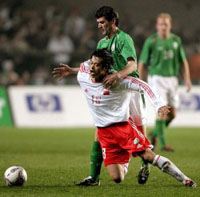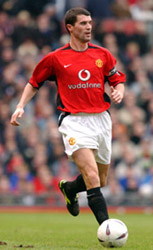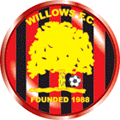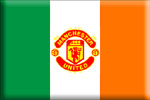Roy Keane – Irish Football Great Roy Keane Roy KeaneIreland V China – Dublin 2005 Roy Keane – A Flawed GeniusIf you ever want to watch Irish people argue simply utter the words ‘ What do you think of Roy Keane ?’ to a group of Irish soccer supporters then stand back and watch. As a divisive soccer figure in Ireland Roy Keane is perhaps matched only by the RTE football pundit Eamon Dunphy. He was a controversial figure already but the events during the build up the 2002 World Cup football finals in the Saipan will follow Roy Keane around where ever he goes. If ever the term ‘flawed genius’ applied to an individual it applies to Roy Keane, an Irish soccer great. A true genius in terms of ability on the soccer pitch but with that genius came a temperamental brittleness that saw Keane get into many scrapes on and off the pitch. The Boy RoyKeane was born and raised in Mayfield, a working class suburb of Cork City. As a boy he played GAA and briefly flirted with boxing but his true sporting love was always soccer. Following in his family tradition Roy joined that famous soccer Cork academy Rockmount AFC in the early 1980’s. Even though he was only nine he was voted player of the year playing football for the Under-11s team in his first year. His favourite program was Match of the Day where he followed the progress of his favourite English team, Spurs. Footballing heroes included Glenn Hoddle and Bryan Robson. His dream from that young age was to play football for a top level English soccer team. The history of Cork football is rich and varied, however when Roy Keane was in his formative years there were no Cork triumphs in the League of Ireland nor the FAI Cup. In the 1985/86 season a new first division was established as an adjunct of the newly formed League of Ireland’s Premier League. One of the founding members of the First Division was Cobh Ramblers and this was where Keane learned to really look after himself on a soccer pitch. After nine years with Rockmount Roy joined Cobh Ramblers in 1989. The First Division was an uncompromising league where no prisoners were taken and hard tackles were the norm. It was not a place for shrinking violets. Even in this hard footballing environment the boy that was Roy Keane stood out from the crowd. His determination and talent was obvious to anyone that saw him play. In February 1990 a Nottingham Forest scout saw him play against Belvedere Boys FC in Fairview Park in Dublin. After just one trial with Forest Roy Keane was offered his first professional contract in English football. This was the beginning of a tumultuous relationship between a sporting force of nature and the wider world of professional football. Neither ever really got fully comfortable with each other. The Keane EdgeIt took Roy a little while to settle into life in Nottingham. He was homesick at times however Brian Clough, not renowned for his caring side, dealt with Keane in a sensitive manner and on occasions let him go home to Mayfield for a few days at a time. Clough did this even though it interfered with Keane’s training routine. Clough was an astute judge of soccer talent. He knew he had a rare football gem in Roy Keane and perhaps he realised that if he had handled Roy less sympathetically he might lose him. Keane’s edginess was evident even then but Clough knew how to balance his own demands for discipline with Roy’s’ need for some latitude. As Keane himself admitted in his biography “…I went to the right club at the right time. That’s what you dream of.” Roy very quickly made an impact with Forest and once he got his fitness up to the required levels he became an ever-present in the first team. In 1991 he played in the FA Cup final against his boyhood favourites, Spurs in a testy encounter. In 1992 he played against his future employers Manchester United in the League Cup Final. Forest lost both finals but the name Roy Keane was very much on the radar of the big clubs. While Roy’s stock was rising his club was heading towards relegation despite his great performances on the soccer pitch. In 1993, and after a brief dalliance with Blackburn Rovers, Roy Keane signed for Manchester United for £3.75m a record English soccer transfer fee at the time. United’s manager Sir Alex Ferguson had been an admirer of Keane for a while and had been impressed by Roy’s obvious lack of respect for reputations. He particularly noted this on the first occasion United played Forest with Keane in their team. Early in that match Roy went in for a tackle with United’s teak-hard captain Bryan Robson and unceremoniously upended the seasoned English international. Ferguson could see in this cameo that Roy had an intense desire to win and that this could be harnessed for the benefit of United as the club stepped up the pursuit of their Holy Grail – a Champions League final victory. Keane the Man U ManManchester United had just won the Premier League for the first time since the halcyon days of George Best, Bobby Charlton and Denis Law. The club had a fantastic balance of experienced pros and young rising stars. It was almost the perfect place for the young Roy Keane. Great players with experience such as Robson, Paul Ince, Steve Bruce and Eric Cantona would pull him along. Young starlets such as Ryan Giggs, David Beckham and the Neville brothers were there to push him out of any possibility (however unlikely) of complacency. In this United team, and with Ferguson as manager, Keane found a kindred ethos and desire to win at all costs – and win they did! During his 12 years with the club, in an unprecedented run of success, Roy Keane and Manchester United, won 7 Premier League titles, 4 FA Cups, 1 Champions League Title (even though he missed the final through suspension he was still awarded a winners medal), 1 Inter-Continental Cup, and 4 FA Community Shields. Keane captained the club from 1997 replacing Eric Cantona and it is generally agreed that he was one of the most inspiring captains Manchester United has ever had. Although the team meant everything to him and he detested individuality he did win personal honours too. In 2000 he won both the Football Writers’ Association Footballer of the Year award, and the Professional Footballers’ Association Players’ Player of the Year award. In 2004 he was inducted into the English Football Hall of Fame. Cork Celt at Celtic FCRoy Keane’s career with Manchester United ended in a degree of acrimony as he became increasingly frustrated with, what he perceived as, falling standards on the football pitch. Following a controversial interview with the club’s TV channel where he was harshly critical of some of his team mates, Keane and Ferguson agreed that he should leave the club. This paved the way for Roy to join his favourite Scottish club – Celtic FC – in December 2005. Although Celtic won the league and cup double in that season his time with Celtic was frustrated by ongoing injury problems that had plagued him for most of his soccer career. Though he only made ten appearances between January and June 2006 this was enough to earn him a Scottish Premier League winners medal and a Scottish League Cup winners medal. Roy Keane retired from competitive soccer in June 2006. Association Football had been enriched by a supreme footballer with an unbelievable will to win that influenced all those that played with him and those that watched from the sidelines. Soccer is poorer since his retirement but perhaps what is not missed so much is some of the controversies that seemed to follow Roy Keane around. Roys’ Red MistKeane accumulated 12 red cards during his Manchester United career. Of course this was reflective of his combative style of play on the pitch but there was more to it than that. His will to win was almost a will to win at any cost. In many instances this caused (what is commonly referred to as) the red mist to descend which would blind Roy to the possible consequences of his actions as raged and railed at opponents, match officials and even team mates. Unfortunately his lack of temper control allowed some opponents to bait him into reckless actions that drew red cards from the referee. A notable example happened in September 2001 when Alan Shearer of Newcastle United infuriated Keane so much that he threw the football at the English striker and then lashed out at him. Perhaps some slack could be allowed to for such incidents due to Roy Keane’s utter commitment to win however it is hard to excuse the more vindictive and downright vengeful aspect of the Keane character. In a Champions League match against FC Porto in Estadio do Dragao while United trailed 2-1 Keane chased after a through ball into the Porto penalty box. The Porto goalkeeper, Vitor Baia went to ground and collected the ball. While the keeper was still on the ground Keane needlessly and willfully stood on Baia. Unsavory as that incident was it pales considerably when compared to the infamous Alf Inge Haaland episode. In 1997 Keane had been injured while playing against the Norwegian. By his own admission in his book, Keane: The Autobiography, Keane waited until April 2001 to exact revenge on Haaland for “sneering (at Keane) about fake injuries”. In the autobiography Keane states clearly that he “had waited long enough” to extract revenge. And revenge he got. In a particularly nasty incident Roy made no attempt to play the ball and smashed his studs into Haalands’ knee cap. The Norwegian underwent two major operations on his damaged knee subsequently. While it is unclear if it was entirely related to the Keane-inflicted injury Haaland was forced to retired from professional soccer in 2003 at the age of 30. Keane Green Mist in SaipanNo controversy has ever hit Irish sport quite like the Roy Keane – Mick McCarthy explosive disagreement in Saipan. It occurred at a time when the Republic of Ireland soccer team was preparing for the 2002 World Cup finals in Japan and South Korea. After a Keane-inspired qualifying campaign, that included a fantastic victory over the very talented Dutch team, the Irish team travelled with realistic hopes of improving upon the quarter-final place achieved in the 1990 World Cup in Italy. Following on from a disagreement with goalkeeping coach Packie Bonner, and unhappiness about the training facilities and equipment in Saipan, there was an major row between Keane, the team captain , and the team manager McCarthy. In midst of all this angst Roy gave an interview to Tom Humphries of the Irish Times. The content of it infuriated McCarthy. The Irish team manager called a meeting of the entire squad to trash matters out. The consequences of this were that Roy Keane returned to his home in Manchester and took no part in the World Cup Finals. To this day Irish people are divided on the issue. On one side of the argument there are those that say he was wrong to leave the team when his country needed him most. The pro-Roy camp are certain that he was right to stick by his principles and that the Irish soccer administration is more professional now because he took the stand that he did. Regardless of which side is right it is clear that Roy Keane paid a high price for the green mist that fell during the Saipan affair in 2002. For a player of his quality to have just one World Cup Finals appearance (USA 1994) on his CV is a major disappointment for all Irish soccer fans. Click on this link for a detailed Saipan Incident analysis. Keane the International FootballerIt is a real shame that the Saipan affair will forever scar the international career of a truly great Irish soccer star. Roy Keane had many outstanding matches in the green jersey of the Republic of Ireland team and since his retirement he has been sorely missed. Ireland has not qualified for another major soccer finals since 2002. Roy won his first full international cap for the Republic of Ireland in 1991 and he went on to win 67 caps playing soccer for his country scoring nine goals along the way. Injuries and a dislike of playing friendly international matches denied Keane the opportunity to amass the amount of caps that his football talents deserved. The 1994 World Cup Finals under Jack Charlton in the USA remains the only major football competition finals in which Keane competed. He was voted the outstanding Irish player in the tournament. Good as his performance was in that World Cup campaign he was even better during the the qualifying campaign for the 2002 World Cup. In a group that included outstanding Dutch and Portuguese teams Keane produced a succession of performances that drove Ireland to automatic qualification from the group. It is ironic and sad for all Irish soccer supporters that the player that almost single-handedly qualified the Republic of Ireland for the World Cup finals did not go on to play in those finals. Many soccer supporters believe that Ireland could have made it to the semi-finals in 2002 if Roy Keane had played. Keane did not play soccer again for Ireland while Mick McCarthy was the manager. Following the appointment of Brian Kerr as manager in 2003 Roy Keane made a return to the international soccer stage against Romania in April 2004. Unfortunately for him, and Ireland, at this stage Roy was continually struggling with injuries and he did not manage to produce too many of his trademark towering performances under Kerr. Keane finally retired from the international soccer team after the unsuccessful 2006 World Cup qualification campaign. Roy Keane – Soccer ManagerIt is somewhat ironic that Roy Keane became the manager of Sunderland AFC in August 2006. The Sunderland chairman at the time was Niall Quinn who had openly and vocally supported Mick McCarthy during the Saipan affair. To onlookers there appeared to by a lot of bad blood between Quinn and Keane. Nevertheless Keane began his football managerial career with the Northeast club. When he took over at Sunderland the team had been relegated from the Premier League in the previous season, were managerless, winless, and were languishing in the relegation zone of the Championship. The Keane approach to soccer management appeared to markedly different to his approach to playing football. Most of the time he appeared to be very calm and displayed little emotion towards the happenings on the pitch when his team were playing. Whatever might have been going on behind this calm exterior his approach was instantly successful. He dragged the Sunderland team from the bottom of the league to an automatic promotion place. Roy Keane returned to the Premier League as a football manager for the 2007/08 soccer season. That season proved to be quite difficult and Keane could not maintain the same rate of improvement shown in the previous season. Nevertheless Sunderland did manage to hold on to Premier League status. To many observers Keane was deemed to have done a good job in keeping the club up when relegation looked a distinct possibility. Roy resigned from his position as manager of Sunderland in December 2008 after a succession of poor results that left the football club teetering on the edge of the relegation zone. In a subsequent interview with Irish Times Keane attributed his departure to differences he had with Sunderland majority shareholder Ellis Short. On 23rd of April 2009 the great Irish footballer Roy Keane was appointed as the manager of Championship club Ipswitch Town on a two year contract. In his first press conference as Ipswitch manager he suggested that promotion to the Premiership was a realistic target withing two years. In his first season in charge at Portman Road the team finished in 15th position with 56 points – exactly half the total of champions Newcastle United. Despite a bright start to the 2010/11 season results began to tail off amid ongoing reports of trouble between Keane and some of his players. With Ipswitch Town languishing in 19th position, just three points above the drop-zone, Roy Keane was sacked on 7th January 2010. Roy Keane Caps & Goals Roy Keane – Manchester United & Ireland Statistics |
 |
|
References :Keane: The Autobiography; Roy Keane & Eamon Dunphy (2002); Michael Joseph Ltd Irish Devils – The Official Story of Manchester United and the Irish
 |
Irish Football Players – All Republic of Ireland FootballersJohn Aldridge – George Best – Packie Bonner – Liam Brady – Shay Brennan – Noel Cantwell – Johnny Carey – Gerry Daly – Mal Donaghy – Derek Dougan – Damien Duff – Tony Dunne – Eamon Dunphy – Johnny Giles |
|
Republic of Ireland Football Managers – Irish Manager’s Records Mick Meagan – Liam Tuohy – Sean Thomas – John Giles – Alan Kelly – Eoin Hand – Jack Charlton |
| Manchester United – Irish Man Utd Players |
| George Best – Jonny Evans – John Giles – Roy Keane – Paul McGrath – Patrick O’Connell – Liam Whelan |





